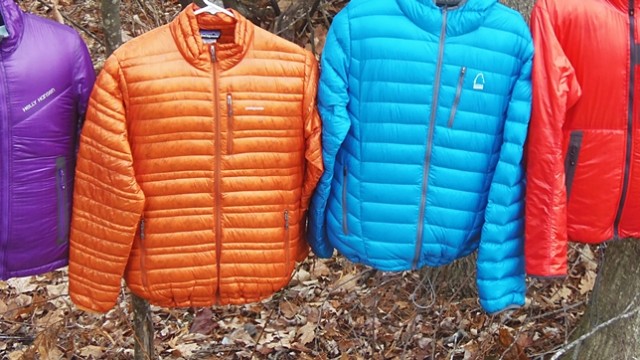The puffy jacket, unlike Jerry Seinfeld’s puffy shirt, is an iconic part of winter layering. Perhaps the most versatile insulation layer out there, puffy jackets are theoretically designed to function as a mid layer, but also does duty as an outer layer or a driving jacket or a camp sweater…or most anything else you can think of. There may be an inveterate outdoorsperson that doesn’t or hasn’t owned one, but we haven’t met them yet.
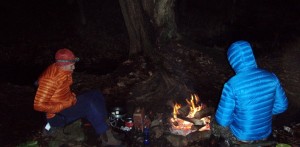
And, typically, they follow a specific pattern, varying only in the details of fit or thickness. Most puffy jackets have a modified “Michelin man” look, with stitching that emphasizes the puffiness and holds the insulation in place; they have short stand-up collars that nicely fill the gap between your neck and a shell and provide coziness as you get your campfire going; and they weigh from 12-16 ounces in down, and 15-20 in synthetic. Sure, there are variations that go beyond those limits, but they’re mostly slight deviations from the standard.
But every once in a while, a manufacturer steps off the familiar path, finds some “magic mushrooms,” and the resulting dreams lead to a redefinition of the category. We found oddball versions of puffy jackets from Patagonia, Sierra Designs, Helly Hansen, and Columbia, and decided to see if it was worth shifting the paradigm, and, well…we ended up shocked, and very, very happy. Each provided some real advantages to the right user; read on, and see if you recognize yourself!
Patagonia Men’s Ultralight Down Jacket, $279, 8.4 oz.

Seriously, an 8-ounce jacket that isn’t very puffy and packs down to the size of a softball…how warm can it be? Well, testers were simply shocked by how cozy the Ultralight was. The ridiculously light shell material also turned out to be remarkably wind resistant. Through-seam construction means that some wind gets through, of course, but with the jacket so “unpuffy”, testers expected to get chilled with every breeze…and didn’t. Part of that has to do with the cut, which is very form hugging, particularly in the arms; if you’re a “between size” person, go to the next size up. But, it has more to do with the quality down fill and the shell characteristics, as smaller testers cinched the drawcord at the waist and professed themselves warm and happy (and that little extra length in the back was praised by everyone who had to stand or sit with the wind behind them). One tester, more cynical than most, used it as an outer layer on a 30ish day at Cannon Mountain; he came back a bit sheepish, admitting that it was warm enough and breathed well enough that he stayed comfortable run after run.
The lightness comes with a price, however. No, it’s not as warm as our stalwarts…just a lot warmer than the weight difference would suggest. If you tend to run cold, it may not be your best choice, particularly in drafty, minimally heated backwoods cabins. And if you’re hard on equipment, no way; the fabric is just plain too thin to put up with major abuse. But if you’re an ultralighter, or someone who likes having an extra layer tucked into their pack when they’ve got room for it, it’s hard to beat this one. Take it with you when you’re wandering the mountains during the shoulder seasons, or at the edge of winter when it can be 50 one minute, 20 the next, and you’ll be glad you chose a jacket so light that it’s always with you!
Sierra Designs Gnar Hoody, $199, 12.3 oz.
Usually any midlayer jacket with a hood ends up in our “not ready for prime time” category. Why? Because the blasted hood gets in the way of everything. If you’re wearing a shell, the hood gets caught up in it; if you’re driving a car, it gets in the way of the headrest. Hoods are, for the most part, simply a pain in the neck, and we expected the same from the Gnar Hoody.
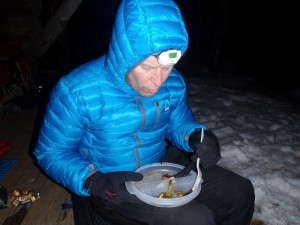
And we were wrong. Sierra Designs has produced a jacket with a hood that seemingly disappears when you aren’t using it. By putting a light, thin elastic binding around the edge, they’ve removed the cord that tightens a hood down. There’s a tradeoff; the hood can’t be cinched down around your face…and we’re happy with it. Usually, in the kind of conditions where we really care about that, we’ve got a shell jacket on, and can cinch that hood down, pulling them both tight. In less extreme conditions, pulling the loose hood over your head leads to an immediate feeling of warmth without constriction; you can even actually hear pretty well while wearing it.
The jacket itself is a lightweight down, thinner than the typical “puffy.” But, with the hood up, it’s as warm as most, and it’s warmer than a jacket/hat combo in most windy conditions, thanks to the hood blocking that miserable draft that crawls down the back of your neck. Testers particularly loved it while sitting around campfires on blustery nights; they could sit on the windward side of the fire, avoiding the smoke, and stay warm on the front while ignoring the blasts from behind. It was also a boon when pushing the limit in “flip” sleeping bags (stay tuned for a review . . ), since those have no hoods. When the mercury started to disappear, crawling into the flip bags in a thin jacket with its own hood really extended the comfort range.
Fit, unlike the Patagonia, is generous, particularly in the arms. A fine and much-appreciated detail is a covered thumb loop in the hem; when your thumb is out, there’s no gap that allows wind to shoot up your arm, but with the extra arm length you can comfortably use the jacket as a half-glove (or in extreme conditions, pull the arm down into your glove/mitt. The thinness of the jacket means it’ll work with all but the tightest glove cuffs). The Gnar was also the longest jacket in the test; it covered hips well on even the tallest editor.
Helly Hansen Odin Isolator, $280, 13.6 oz.
Is your idea of a good time getting caught in a 34 degree downpour in the White Mountains? Or hiking in a howling wind that brings tears to your eyes? If that’s you, you owe it to yourself to check out the Odin Isolator.
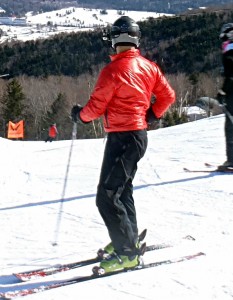
The Odin is the only synthetic in the test, and a first look says “pretty, but not warm; it’s too thin to be of much use.” And the first look is totally wrong. Some great design choices make the Odin the most versatile of any of the jackets here.
The first choice was the use of PrimaLoft INFINITY continuous filament insulation. We’ve always been fans of PrimaLoft; yes, there are other excellent synthetics out there, but any time we see that PrimaLoft name, we trust that the performance will be there. And the INFINITY allows Helly Hansen to use a welded construction, bonding the insulation directly to the shell. That choice leads to the two other major choices that make the Odin so special.
Welded construction = virtually no seams = virtually no wind getting through = much more warmth than would be expected with a relatively un-puffy puffy. Even in static conditions, sitting around camp without a lot of wind, the Odin is warmer than we expected. It’s in wind, though, that we started to get a feel for what the jacket was going to mean to us. Heading to the Gaspesie for backcountry skiing? The Odin will zip up and block the most miserable gusts above treeline, yet breathe well enough that you don’t turn into a total sweatball as you climb. And, of course, even if you DO turn into a total sweatball, it will still insulate you, unlike the down jackets. The slim profile gives it a stylish look that allows it to fit in in the anti-EasternSlopes.com world of cities; tall buildings concentrate winds to ridiculous levels, and two editors who hit Boston and New York in the Odin walked tall and smiling while others around them huddled down into their black (of course) wool coats.
But at least as important to the Odin’s mission is that every pinhole created by a needle going through nylon lets water in. With minimal seams on the “up” side of the jacket and a superb DWR finish, this nearly doubles as a rainjacket. One tester spent two hours in a hard drizzle one morning in camp when the forecast had said no rain; after packing up and getting to the cars, he was dry and comfortable except around the edges. As for the Odin, he hung it over the passenger seat on the 2 hour drive and it was entirely dry by the time he got home. Another, just for the fun of it, wore it while snowblowing, or more accurately slushblowing, his driveway during one of those miserable storms that dumps 6 inches of snow, then turns to sleeting rain for a few hours. After an hour plus in the driveway, he reported that “the cuffs were a bit wet where water ran down the sleeve into my gloves, but I was dry and comfortable everywhere else.” After that, it became the “demand jacket” for spring kayaking adventures, where there are more ways to get yourself and your clothing wet than Carter has little pills.
One final, seemingly small but very nice, design choice was putting in a draft skirt at the waist rather than a drawstring at the hem. That blocks wind, but doesn’t make the jacket tight around the hips or cause it to pull up over your butt when you really want it to be DOWN! We tested both women’s and men’s versions of the Odin, and that feature was particularly valuable for the women testers; many jackets tend to ride up for them.
Fit? Dead between the Patagonia and the Sierra Designs. Long-armed testers found it adequate; long bodies wished for a little more length to pull down over their hips and butts.
Columbia Powerfly Omni-Heat Jacket, $200, 14.4 ounces.
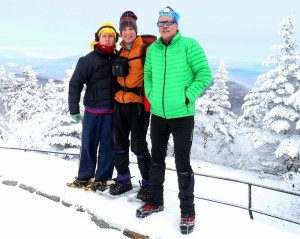
The first two testers to take this jacket out gave exactly the opposite feedback. “Wow…I felt like I’d added an extra layer, not just swapped out jackets!” raved the first one. Great…until the second one said “It was okay, but…it just never felt really warm.” Hmm…we tend to get differing viewpoints on the details of a product, but not usually on the basic function! More testing and testers later, and the picture started to clear up; and it came down to what the tester was doing. People who were being active; downhill skiing, snowshoeing, etc. absolutely LOVED it. And people who were hanging around a cabin or tent, or watching an XC ski race…well, not so much. And that makes sense when you realize that Columbia’s Omni-Heat technology is a radiant barrier. See all the little shiny dots in the picture? Those are little bits of metal imprinted on the fabric. If you’ve ever owned a Space Blanket, you know exactly what the deal is; they reflect heat back with a very high efficiency, and Omni-Heat is pretty much a Swiss cheese version of that. The problem is that in order for it to work well, you have to be radiating heat that it can send back to you. So, standing in the cold with a low heartrate and no blood in your capillaries doesn’t help Omni-Heat to do its job at all; and, in fact, since metal is a conductor of heat, it’s actually probably helping to carry heat away from your body. But move a bit, get the blood flowing to the skin and the extremities, and all of a sudden it’s a different story. Once we’d figured THAT out, we sent the Powerfly back out to testers and said “give this a try while downhill skiing.” And to a person, they raved about it. On the way down, they’d get their hearts pumping; and on the long chairlift ride back up, all that heat was being reflected back to them. This isn’t the puffy for backpackers; at 14.4 ounces, it’s the heaviest in the test. Rather, this is for the active sports enthusiast who’s not afraid to get out there when it’s REALLY cold and burn calories, where more warmth from a thinner package is more important than the fewest grams possible.
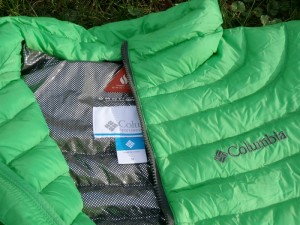
Fit, like the Patagonia, is on the slim side; they’re not expecting you to wear a lot of layers underneath, as the Omni-Heat replaces extra layers when you’re working hard. One backcountry ski enthusiast appreciated that; it fit better under his light shell for the downhills than his regular insulation layer, and also took up less room in his pack while he was skinning back up the mountain.
The Takeway
So…what puffy jacket to choose? And should you buy one of these if you already HAVE a good puffy? Well, we’re gear addicts, and the ability to choose our jacket for the specific conditions is appealing. But, reality sets in, along with a budget. Still…we can maybe justify ONE of these, along with our standard fare. The key is to know yourself, and think about the times your regular jacket isn’t ideal. Peakbagger who tries to go as light as possible to catch that break in the weather and speed to the top? The Patagonia, no doubt; it won’t weigh you down, and it MIGHT save your life if you aren’t as fast as you hoped you’d be. Stuck on belay, or any other situation where you have to stay pretty much still for long periods? Oooh, that hood on the Sierra Designs is awfully cozy and appealing, and might make up for your lousy sleeping bag, too. Too stubborn to change your plans and stay in when the weatherman inevitably admits that his usual 30% accuracy has dropped to 20%? Make sure the Odin’s in your pack. Go/stop/go/stop, as in downhill skiing? The Powerfly will take advantage of the heat you generate when you’re active without the bulk of a heavier insulating layer. Us? We’re hoping that Santa recognizes that all four of these together are lighter and take up less space than most single jackets, and leaves them all under our tree!


